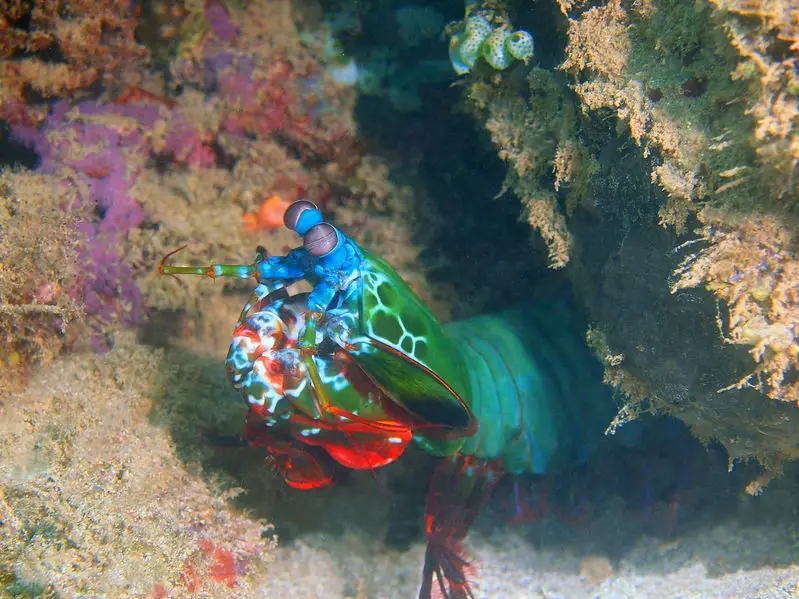4 Animals That See More Colours Than Humans
For quite some time it was thought that animals, in general, were not capable of seeing colour in the way we humans do. After some time though we managed to figure out that there is some truth to it, but it is far from the full truth.
We have concluded that most animals simply don’t have the optical capability to see the same as us, such as cats and dogs who can only see with 2 base colours instead of 3 like humans have.
However, we have also discovered that there are animals with far more complex vision than ours when it comes to pure colour vision. In this list, we will go through some of our top picks for animals that can see more colours than we can!
The Mantis Shrimp

The mantis shrimp is a colourful little creature with claws strong enough to stun prey up to 200 lbs (91kg). These little guys can grow up to 7 inches long (~18cm) and resides in the reefs of the Indian and Pacific oceans.
Despite being very capable creatures as they are with a claw force strong enough to break through the shell of crabs, this is not even close to their strongest attribute and the one that makes them so reputable in the animal kingdom.
It turns out that these little guys have (as far as we know for the moment) the most advanced colour vision we have ever seen. For a full article on the mantis shrimps’ amazing eyes structure and colour vision we recommend you go to this article.
As we know humans only have 3 different photoreceptor cells in our eyes, that allow us to see red, green and blue. This species of shrimp possesses a mighty 12 different photoreceptors with some even found to have 16 different ones, all of which add more depth to their colour vision.
One common misconception however is that since they have 4 times the amount of different receptors than us that they would be able to see in colours that we could never even begin to imagine. There are bits of truth in this but it is not nearly the full story.
The full truth is slightly different than what we might imagine. Through some rather extensive research on how well the shrimp can tell the difference between different wavelengths of light, they were able to conclude that the shrimp actually are not that great at differentiating between different colours.
The shrimp are able to differentiate wavelengths of around 25 nanometers apart while humans can detect differences in around 1-4 nanometers. To put that into a visual perspective, the shrimp can detect differences that for us are about equivalent to the difference between darker greens and lighter blues.
That being said though, it does have capabilities that we humans can’t even imagine that is directly linked to the biological structure of its eyes.
For quite some time it wasn’t actually known why they have so many different photoreceptors, because for us it seemed rather strange that the species evolved this way when they really would only need 3 or 4 for sufficient colour vision.
Research has however shown that it serves other purposes that we didn’t exactly anticipate. The main example of this is the fact that their colour recognition, despite their differentiating abilities being on the weak side, is extremely advanced.
Since they have all these different types of receptors in their eyes they are able to detect changes in the surroundings somewhat easily. This ability proves to be very useful for them since being able to detect sudden changes in the brightly coloured reeves they live in could save them from a bitter fate.

With that information, you could sort of say that they “see with their eyes” more than they do with their brain, in a similar fashion that we do. What I mean by that is that for us it is crucial that the information the eye picks up goes back into our brain to create an image whereas for the shrimp it doesn’t need to do that, in the same way, to still be able to process changes in the environment.
However, that is about as far as it goes for the time being with the research conducted on these guys. We still have a lot to learn about their vision and how it is used to perceive the world in ways we don’t understand yet.
Butterflies

The next animal on this list might not seem so surprising, but it is the butterfly. Butterflies may be tiny but have some of the most complex eyes there are in the entirety of the animal kingdom.
Most butterflies have around 6 sets of cones in their eyes, with one species of butterfly (the Japanese yellow swallowtail) that has been found to possess an impressive 15 different photoreceptors.
Does this mean that they have a base colour for each type of cone like we do? Not quite, since it works a little bit differently when we get to this amount. It still holds true that the different receptors react to specific wavelengths of light, it doesn’t exactly correspond to colours in the exact same way as it does for us.
There are some extensions it gives though, for example, it allows them to see “between colours” in a way that we can’t and it also gives them the ability to see light within the UV spectrum.
For more information on what butterflies (as well as other animals) do with their UV vision abilities, make sure to check out our article on Ultraviolet Vision Among Animals.
Studies on the subject have shown that not all 15 photoreceptors are used for colour depth though. When training butterflies to react to different wavelengths, they discovered that their vision mostly consists of red, green, blue and UV. This makes their vision actually somewhat similar to ours, except for the addition of UV light sensitivity.

One interesting thing we can note though is the fact that their ability to distinguish between different shades of colours is actually on a comparable level to ours. The difference however is that the butterflies vision is simply able to see more colours between shades but simply can’t distinguish between them since they are so precisely similar.
With all of this information present, we might ask ourselves why exactly butterflies evolved this way and why they need all these different types of photoreceptors. And the short but most accurate answer is that; we simply don’t know yet.
There are very educated guesses as to what the functions of all the photoreceptors might be, but science has not been able to come up with fully conclusive evidence for these speculations.
One speculation is that some of them serve a few very specific purposes, which would make sense from an evolutionary standpoint. An example given of this is rivalry during mating-related confrontations between the butterflies.
For example, since a butterfly can distinguish colours between the green/blue spectrum pretty well they can detect when a rival butterfly is either above them or below them. This could otherwise be a difficult task since a blue butterfly would blend in with the sky and a green one would blend in with the grass/trees below.
So with that said, even if butterflies have some very good camouflage to the point where we would have problems seeing them, another butterfly would be able to see it without any problems.
This is however only speculation like previously said, nothing is fully established yet but this theory seems to be accurate as far as we know it today. Further research needs to be conducted in order for it to be conclusive, but that should come soon enough as science always seem to progress rather quickly.
Pigeons

This next one might surprise you a bit, but actually, it turns out that the infamous pigeons actually have a superior colour vision to us. It might not be the most surprising thing considering that birds in general have pretty good vision, but to think that the otherwise dorky pigeon has better vision than us is a rather amusing thought.
So how is the pigeons (as well as other birds) colour vision better than ours? To begin answering that question we can first address their chromatic system, which is what defines how many different photoreceptors a creature has.
The research on this specific aspect is slightly inconclusive, but they have been able to establish that they have at least 4 different kinds of photoreceptors but that there is evidence that suggests they have more than that.
Much like us humans, they have the 3 “regular” cones which represent red, green and blue. The difference here is that they have an additional one that allows them to see UV light as well, much like the butterflies and also other species of birds.
One thing that makes pigeons rather interesting specifically though is that during the research process of them they weren’t actually able to establish how low their sensitivity to UV vision was. This is because they used simply couldn’t simulate rays under 360nm due to optical problems with the machines being used.
That said, there definitely needs to be more research done on the subject in order for anything to be conclusive. This is where it gets interesting though because usually, other birds’ UV vision stops around there, meaning that they haven’t even had to use tech that could go lower than this before.
This is also where the speculation of a 5th cone comes from. Since they are able to register UV rays beneath 360nm they suspect that they might have an additional cone that is sensitive to the shorter wavelengths.
This would also make sense since they are also surprisingly good at distinguishing between different wavelengths of UV light. It makes sense in the same way as how when we have 2 eyes we gain depth perception, except with 2 UV cones they are able to distinguish different UV rays from one another due to better UV depth perception.
With this information on the table though, there needs to be more research done in order for any conclusive evidence. It does however show a lot of promise given the research already done.
Goldfish

If somebody told you that a goldfish is able to see more colours than you, what would you say? Chances are you would laugh in their face, but when it comes down to facts this person would be absolutely right.
Goldfish and a lot of fish in general have the same base colours that we do but with the addition of the photoreceptor for ultraviolet light, similar to pigeons. Goldfish in specific have a visible wavelength spectrum of about 277-737nm, which is somewhat similar to us humans but goes way further down the UV spectrum than our vision do.
They managed to come to these results by simply supplying them with different wavelengths of light to see how they react to them. They found that they react to (and therefore see) light within our visible spectrum as well as within the UV spectrum.
One thing to note though is that goldfish, unlike the other animals on this list, don’t have a whole lot of photoreceptor cells in their eyes. They have the 4 different types of them that we already mentioned, but the quantity of them is rather low compared to the others on the list.
There aren’t actually any conclusive studies on any exact numbers, but when talking in the ballpark range it doesn’t even come close to the millions that would exist in a mantis shrimp’s eyes.
It doesn’t exactly impact their vision by any means, it doesn’t give them any sort of disadvantage, it is however an interesting metric to know.





